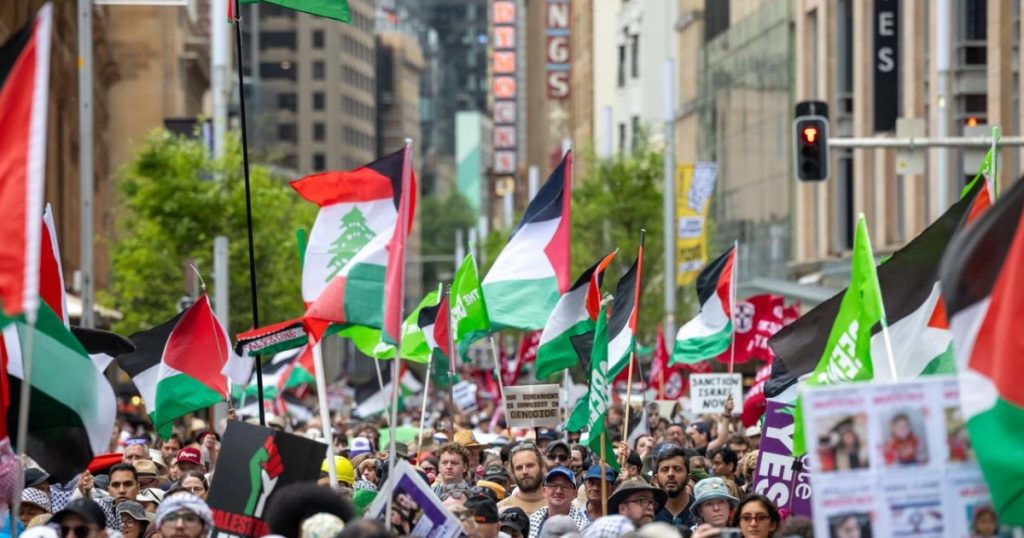Listen to the article
Australian authorities and fact-checkers have exposed a digitally fabricated image circulating on social media that falsely depicts pro-Palestinian protesters rallying at the Sydney Opera House in defiance of a court order.
The manipulated image, which has spread across platforms including Facebook and X, shows a large crowd of demonstrators waving Palestinian flags in front of the iconic Sydney landmark. An accompanying caption claims: “Thousands March in Sydney: Pro-Palestine Rally Defies Court Blockade on Second Anniversary of Gaza Conflict Despite a Supreme Court ruling prohibiting the gathering at the Sydney Opera House.”
While a legitimate pro-Palestinian march did take place in Sydney on October 12, 2025, marking the second anniversary of Israel’s military campaign in Gaza, protesters did not gather at the Opera House. The Supreme Court had specifically prohibited demonstrations at the UNESCO World Heritage site.
AAP FactCheck has confirmed the viral image is AI-generated, pointing to several telltale signs of digital fabrication. Most notably, protest placards in the image display garbled or misspelled text, with the most prominent sign reading “SACTION ISRAEL” instead of the intended “SANCTION ISRAEL.”
Architectural inconsistencies further betray the image’s artificial origins. The Opera House in the fabricated photo appears to have four sails on its northwest structure, whereas authentic photographs show the actual building has only three. The perspective suggests the photo was taken from The Rocks area looking east across Circular Quay, but no actual vantage point in that location matches the depicted scene.
Geographic analysis using Google Street View confirms that the angle shown in the AI image could only be captured from near the Sydney Harbour Bridge’s southeast pylons. Additionally, the fabricated cityscape includes buildings over 10 storeys tall in an area where the tallest actual structure is a five-storey hotel.
Despite its obvious flaws, the image has gained international traction, even appearing on an Indonesian news website, highlighting the growing challenge of identifying and containing AI-generated misinformation across borders.
The incident underscores increasing concerns about the role of artificial intelligence in creating and spreading misinformation about politically sensitive events. As AI image generation technology becomes more sophisticated and accessible, distinguishing between authentic and fabricated visual content grows increasingly difficult for casual social media users.
Media literacy experts advise the public to look for common signs of AI-generated images, including distorted text, unusual architectural features, inconsistent shadows, and improbable perspectives when evaluating protest imagery and other potentially contentious visual content online.
The Sydney demonstration came amid ongoing tensions in the Middle East and growing global activism related to the Israel-Gaza conflict. While legitimate protests continue to occur worldwide, this incident demonstrates how easily digital manipulation can distort public perception of actual events and potentially inflame already sensitive political situations.
Social media platforms continue to grapple with effective policies to identify and label AI-generated content that misrepresents real events, particularly around politically charged subjects with international implications.
Fact Checker
Verify the accuracy of this article using The Disinformation Commission analysis and real-time sources.




7 Comments
The details in this fabricated image are quite sloppy – misspelled protest signs and an incorrect claim about the rally location. Glad the authorities were able to verify the truth.
Yes, the digital manipulation is quite obvious. Good to see official fact-checking to expose this misleading content.
This incident highlights the need for greater media literacy and vigilance against digitally altered content. Fact-checking is essential to combat the rise of misinformation.
This is a concerning example of how AI-generated imagery can be used to spread disinformation. Fact-checking is crucial to maintain public trust in online content.
It’s troubling to see how easily fabricated images can spread online, even when they contradict the facts. Kudos to the authorities for promptly debunking this misleading visual.
Concerning to see this AI-generated image spreading misinformation about the pro-Palestine protest in Sydney. Fact-checking is crucial to counter the spread of fabricated visuals online.
Absolutely, it’s important we rely on credible sources and not easily manipulated digital content. Appreciate the authorities calling this out.